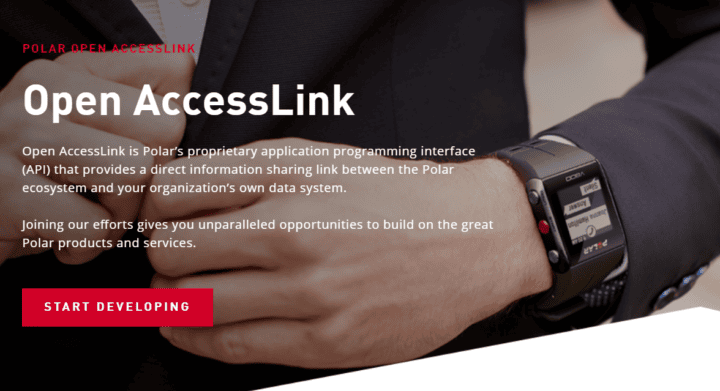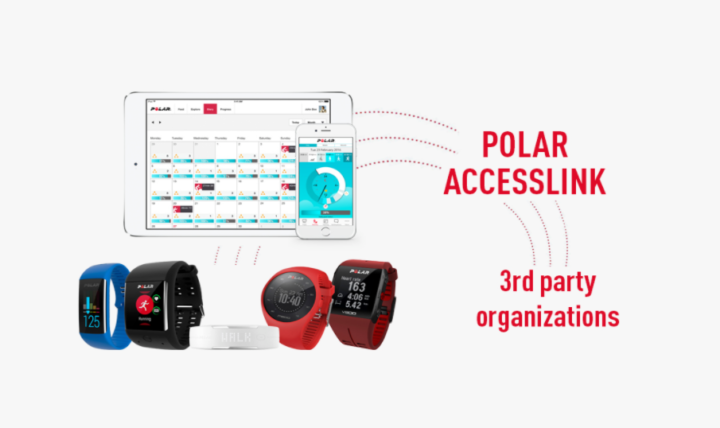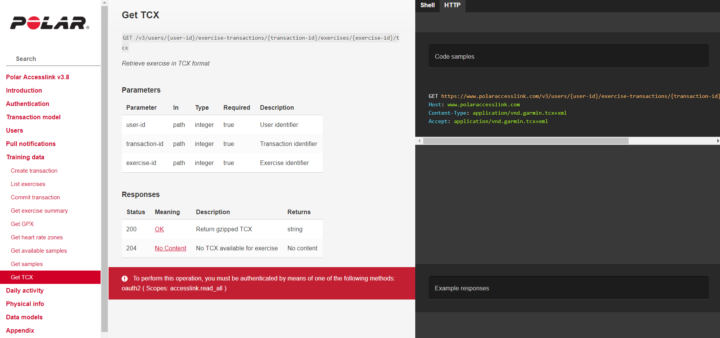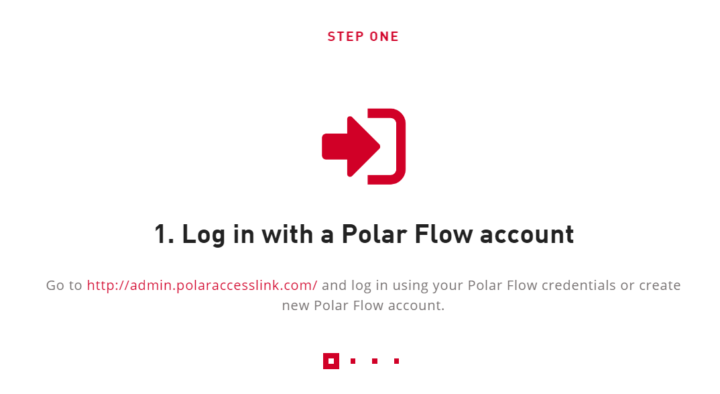
Today Polar announced the ability for app developers to access data within Polar Flow, via their new ‘Polar Open AccessLink’ API. An API (Application Programming Interface) is what allows applications and platforms across the internet to communicate with each other. For example, when you upload a workout to Polar and that magically pushes it to Strava, Polar is using Strava’s API’s. The same goes for when Zwift or TrainerRoad upload to TrainingPeaks – they’re using TrainingPeak’s API’s.
The internet revolves around API’s – almost every site you know of ties into other sites, even if it’s just simple things like being able to share a tweet or post to Facebook.
However, in the sports tech world it’s been slow going. Certainly app platforms like Strava, Xert, SportTracks, and TrainingPeaks have mostly open API’s. But the major watch manufacturers have usually had convoluted and restricted access to the platform.
For example, Garmin has an API to access existing workouts, but that’s limited to companies that either pay a $5,000 fee or get it waived. Suunto technically has an API, but they don’t really allow anyone to actually use it. Apple has Health Kit, but that’s only on a per-phone basis, and not in some cloud system – so that has its pros and cons. And Polar? Well, let’s talk about that.
What Polar is Opening Up:

So up until today, Polar has had AccessLink, which was primarily used for corporate wellness type initiatives. Things like insurance companies, wellness programs, and even the odd fitness application that managed to get through the undocumented approval process. But in the grand scheme of the world, you as a consumer never really used this side of the house.
Instead, you used Polar Flow and before that Polar Personal Trainer (PPT), those being Polar’s two big web platforms. To get your data into those platforms you took one of two main routes: Phone or desktop. With the phone route you used Polar’s mobile apps to sync your completed workouts up to Polar Flow. And with the desktop side you sync’d to either Polar Flow or Polar Personal Trainer (PPT). Here’s the rough breakdown of devices from Polar’s site:
Polar Flow: V800, V650, M460, M450, M600, M430, M400, M200, A370, A360, A300, Loop, Loop 2, Beat iOS, Beat Android
PolarPersonalTrainer.com: RC3 GPS, RCX5, RCX3, FT80, CS500, RS800, RS800CX, RS400
Cats and dogs: Polar S610, Polar S625X, Polar S720i, Polar S725X
That last category basically was things that sorta worked with AccessLink.
In any case, what Polar has opened up is a read-only API to access all of Polar Flow. So anything that’s uploaded to Polar Flow, a developer can now access. That includes workouts, daily activity/step data, and even data about the user – like weight and height. All of this, of course, requires your approval as the end user.
The approval happens pretty much like most other web platforms that allow authorization and integration. Polar’s new AccessLink uses OAuth2 as the authentication protocol, and then once authenticated data is transmitted using JSON and XML. However, workouts are further transferred in more common fitness formats, notably .TCX and .GPX (basically, the same as Polar Flow does today).
All of this is pretty clearly documented here, via their API page (pretty start landing page is here). Additionally, they have a GitHub page with samples here. And finally, developers can register here.

It is notable that at this time the data access is read-only to the Polar Flow data. Meaning that you can’t publish data into Polar Flow….yet. When asked, Polar said:
“At the moment it is purely retrieval. We are looking for possibilities to make it two way connection but we still need to work on that.”
Of course, there are pros and cons to doing so. A company might worry that other companies would leverage it as a backend storage facility for their own products. But ultimately, even Garmin (who has long resisted this to Garmin Connect) has started opening those gates an itty-bitty-bit with allowing training platforms (notably TrainerRoad, Zwift, Sufferfest) to upload files to Garmin Connect.
I’ve of course long argued that anytime you can convince your competitor (I.e. another device company uploading to your platform) that your site/platform is a better place for their data, is when you ultimately win. It’s the best market research you could ever ask for…for free. In any event, for now Polar is focused on just making it possible and easy for developers to pull from the platform.
Overall Thoughts:

So you may be wondering, why do you as an end user care about this? For one, it ensures that your data isn’t locked away. And no other than Polar got themselves into hot water just 2-3 weeks ago over this exact thing, when they announced they were closing their older platform PolarPersonalTrainer.com next spring. But that wasn’t the issue: It was that it would break older watches (the ones listed far up above) from uploading anywhere. Ultimately, they had to backtrack on that announcement after angry mobs started marching towards Finland.
If nothing else, today’s move by Polar basically says “Hey, we’ve got a plan for being more open!”. It may not yet solve all their platform integration gaps, but it goes a good ways towards making sure people can at least access their data via other means.
Further though, it starts to drive developers to ‘Do cool stuff’ with the Polar Flow platform. There are thousands (really, thousands) of apps that leverage data in Strava. Some are ones you’ve heard of, and others probably never (here’s a random list of Strava’s favorites). But many of them do unique and interesting things – and all of them shine visibility towards Strava. Polar’s ultimately hoping that anytime you see an app that can do something cool against your Strava data, that maybe there will also be an icon to do the same thing against your Polar Flow data. And thus, perhaps enticing you to buy a device.
Not only that, but Polar’s API covers areas Strava’s doesn’t – like daily activity tracking. Strava is purely still for workouts, whereas Polar is both workouts and daily activity.
Finally – some might wonder how Garmin compares in all of this. And in short, there’s both overlap as well as gaps. In general, virtually all of Garmin’s devices allow users to access the native files directly on the device via simply USB with no additional software (something none of Polar’s devices allow), as such they aren’t in the same pinch in terms of access to files. But when it comes to API’s, Garmin has a few major methods today:
Corporate Wellness Stuff: Used for entities to access daily activity data, as well as receive workout data. Limited to big companies/partners, largely private. Polar has had this for a while with AccessLink.
Garmin Sync Outbound: This pushes workout files from Garmin Connect to apps like Strava, Sport Tracks, etc… Anyone can sign up for this, but it costs $5,000 – or Garmin decides to waive that fee. There’s not exactly an API, but rather the companies automatically receive a copy of every activity file you create. The end resultant of this is what Polar announced today, though the means are different. Also, Polar’s is open to anyone, no fee or gates required.
Garmin Sync Inbound: This is the newest one that they just opened up in August allowing apps to upload files to Garmin Connect, and only a couple companies are allowed here. Polar doesn’t have anything like this.
Connect IQ Related: Not entirely an API per se, but a way for apps to run on devices, with numerous endpoints. Nothing here for Polar either.
As you can see, both Polar and Garmin have overlap, but also gaps. The biggest difference relative to today’s announcement is that Polar doesn’t have a fee (real or imaginary), and that like Strava, anyone can sign-up instantly and get to work using it. This doesn’t cover all the scenarios, but it’s certainly a really good start.
As I’ve long argued, consumers should own their own data, and companies should make it easy for consumers to get access to that data via whatever apps they deem valuable to them. Today’s announcement by Polar may sound like it’s for the geeks, but ultimately, it’s something everyone will benefit from.
With that, thanks for reading! Oh, and app devs? Get to work.
FOUND THIS POST USEFUL? SUPPORT THE SITE!
Hopefully, you found this post useful. The website is really a labor of love, so please consider becoming a DC RAINMAKER Supporter. This gets you an ad-free experience, and access to our (mostly) bi-monthly behind-the-scenes video series of “Shed Talkin’”.
Support DCRainMaker - Shop on Amazon
Otherwise, perhaps consider using the below link if shopping on Amazon. As an Amazon Associate, I earn from qualifying purchases. It doesn’t cost you anything extra, but your purchases help support this website a lot. It could simply be buying toilet paper, or this pizza oven we use and love.

















